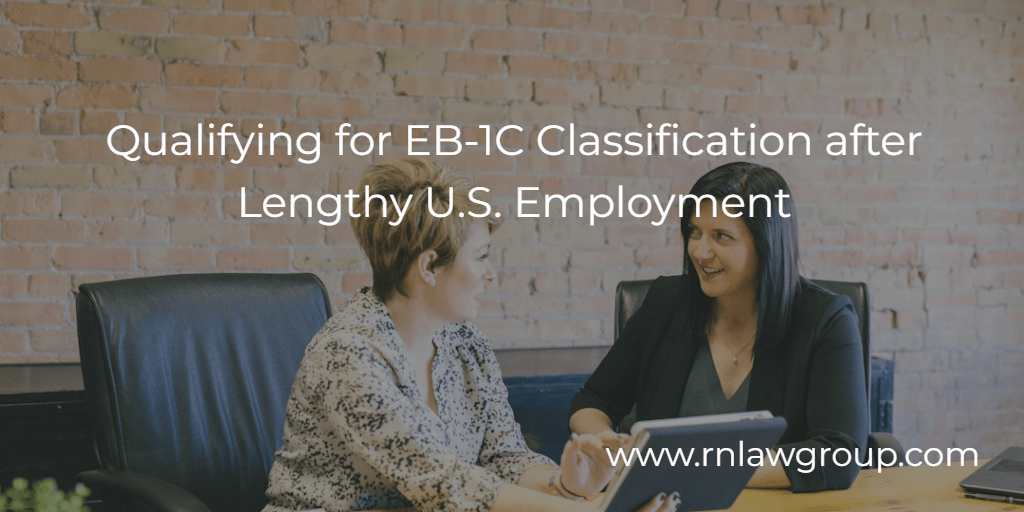
Qualifying for EB-1C Classification after Lengthy U.S. Employment
The EB-1C classification is an immigrant visa category for multinational executives and managers. In addition to allowing for earlier filing for adjustment of status due to being in the employment-based first preference category, an advantage of this classification is that it does not require the sponsoring employer to undergo the lengthy PERM labor certification process. The recent availability of premium processing for EB-1C I-140 petitions also allows for expedited processing of 45 days, as opposed to the prior 8-12 month adjudication time.
Many often assume that the EB-1C category is only available for workers who initially travelled to the U.S. in L-1A status, since the L-1A is the nonimmigrant visa category for multinational managers and executives. However, the EB-1C category is not restricted to L-1A workers, as long as the beneficiary has at least one year of employment in a managerial or executive position abroad within the statutory time period, and is being offered a permanent managerial or executive position in the U.S. within the same multinational organization. Potential scenarios include:
Transferring from the U.S. to a foreign employer and back to the U.S.
In this scenario, the prospective beneficiary has been working in the U.S. for several years, likely in H status, and does not yet possess qualifying work experience with an overseas company that would qualify him or her for EB-1C classification. However, the U.S. employer they work for now is part of a multinational organization, and the employee already occupies a senior or managerial role. The employee likely already has a PERM-based I-140 petition approved in the EB-2 or EB-3 category, but has not been able to apply for adjustment of status because their priority date is not current.
If the employer in this situation is willing to transfer the employee to one of its foreign offices for at least one year in a managerial or executive role, the employee can qualify for EB-1C classification if the company will offer him or her a permanent managerial role in the U.S. after the completion of the foreign assignment. If the employee has a priority date from a prior-approved I-140 petition, the priority date can be ported to the new EB-1C I-140 petition, potentially enabling the beneficiary to concurrently apply for adjustment of status if they have returned to the U.S. in H or L status by then. Prior to the transfer, the company should carefully review the corporate relationship between the U.S. petitioner and the prospective foreign employer, as well as the proposed managerial position abroad and in the U.S., to ensure the requirements for EB-1C classification are met and are carefully documented.
One continuous year of foreign employment
It is important to note that the employment abroad must be for one continuous year. Any time spent physically in the U.S. during this time will be deducted from the one-year employment calculation, and could therefore delay the earliest potential filing date of the I-140 petition. Furthermore, the beneficiary and petitioner should be aware that the prior H visa cannot be used for entry to the U.S. during the foreign employment term, since entry on an H-1B visa would be for purposes of working for the U.S. company. If it is necessary for the beneficiary to travel to the U.S. temporarily while they are employed by the foreign entity, the appropriate visa type would be a B-1/B-2. The B-1 visitor status allows the visa holder to enter the U.S. as an employee of a foreign company for business purposes, such as coordinating with U.S. counterparts, attending industry conferences, or meeting with clients in their capacity as an employee of the foreign company.
Dependent family members
Employees considering a move abroad should also carefully consider the status of their dependents before accepting the foreign assignment – even if the overseas transfer is expected to last only a year, if the employee has dependent family members in H-4 status in the U.S., they will likely need to relocate those family members as well for the one-year employment abroad. Once the H-1B visa holder ceases to be an employee of the U.S. company, the family members’ H-4 visas would no longer be valid, even if the I-94s are unexpired at the time. In order for family members to remain in the U.S. while the employee works abroad, the spouse and/or children would need their own visa statuses, such as H-1B or F-1, that are independent of the EB-1C beneficiary’s H-1B status.
Beneficiary has worked for the same multinational organization in the U.S.
In this scenario, the prospective beneficiary did previously work for the foreign parent, subsidiary, branch, or affiliate of their current U.S. petitioner, but it was several years ago, and they have been in the U.S. in H-1B or possibly L-1B status since then. The beneficiary may also qualify for EB-1C classification in this situation without the need for a transfer abroad, as long as:
- The prior foreign employment was managerial or executive in nature;
- The prior foreign employment lasted at least 1 year within the 3-year period prior to the beneficiary’s transfer to the U.S.;
- Since transferring to the U.S., the beneficiary has not worked outside the multinational organization for a period of more than 2 years; and
- The U.S. petitioner is now offering him or her a permanent managerial or executive position.
Documenting the prior foreign experience
In these circumstances, one of the primary challenges is documenting the managerial experience abroad, since it would have occurred several years ago. Even if the employee is now in a managerial or executive position in the U.S. office and has been for several years, it is still necessary to establish that their work in the foreign entity was managerial in nature. Examples of supporting documents include:
- An organizational chart that shows the beneficiary’s position during this time (a “snapshot” of what the department or company looked like at the time the beneficiary was a manager there several years ago, which is likely different from the foreign company’s current organizational chart);
- Personnel records of the individuals who were the beneficiary’s direct reports at that time, to show they were either managerial or professional-level employees; and
- Evidence of the beneficiary’s managerial duties, such as performance reviews they completed for their subordinates, hire/fire paperwork they signed off on, status reports or requests for authorization sent to them, etc.
Depending on how long it has been since the beneficiary worked for the foreign entity and the record-keeping in the foreign entity, these documents can be challenging to compile.
Avoiding inconsistent statements
In addition, the employer would need to ensure that there are no inconsistencies in its statements about the foreign experience in the EB-1C petition, and statements about the beneficiary’s experience in other immigration applications. The company would have difficulty arguing the employee’s experience abroad was managerial, for example, if the PERM labor certification filed on their behalf listed their experience with the foreign company as non-managerial in nature, or if the employee described their past experience on a DS-160 form in a way that conflicts with the EB-1C petition’s statements.
There are therefore potential ways for foreign national employees who have been in the U.S. for several years to qualify for EB-1C classification, with their company’s support. Prior to initiating any foreign transfers or preparing documentation though, employers and employees are recommended to consult with immigration counsel to ensure that the facts and documentation support an EB-1C petition, and that all parties are aware of the implications to status and/or family members of the prospective beneficiary.
By: Rebecca Chen
Rebecca Chen is a Partner at Reddy & Neumann. Her representation includes advising clients throughout the non-immigrant and immigrant visa application process, from initial filing, responding to various requests for evidence, and processing at overseas consulates. Her years of experience in the immigration field have made her a knowledgeable resource for complex business immigration matters.

